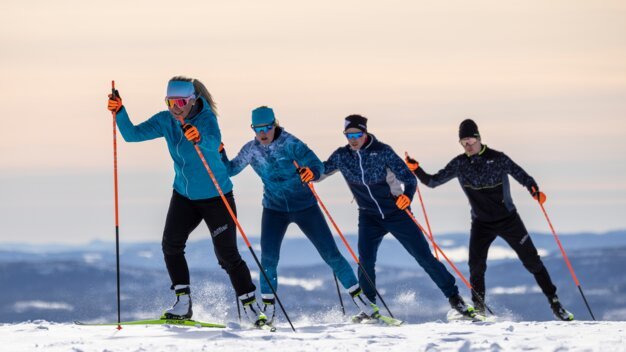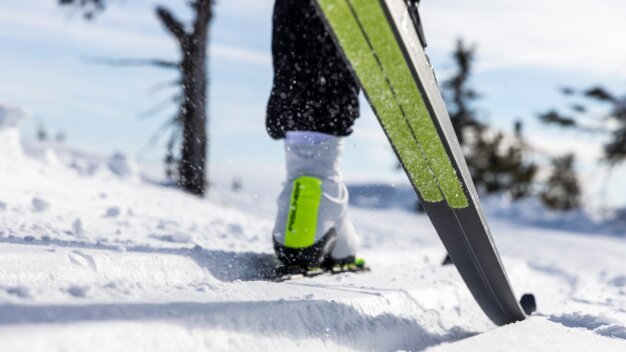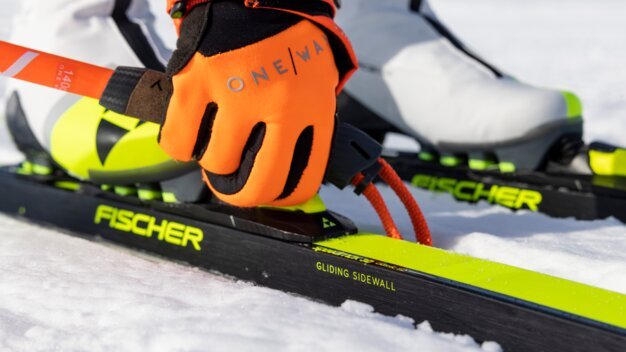
There’s a glistening blanket of snow everywhere. The sun is shining. It’s your day off. And you finally want to give cross-country skiing a try? Great decision! However, do you have everything you need for your first time on the trails? Or is there an essential item of equipment missing?
To find out what equipment you really need as a cross-country skiing rookie, read the information below. Let’s get started – here’s your equipment checklist for unforgettable cross-country skiing adventures
Skis
Obviously, your Alpine skis are the wrong choice for the cross-country trails. You will have seen that other cross-country skiers wear much narrower skis while gliding through the snowy landscapes. Here’s what else is different to Alpine skis:
Cross-country skis …
- … are slimmer.
- … are lighter.
- … have only a minimal sidecut.
- … have a relatively high camber.
- … are designed more for gliding.
Two cross-country skiing techniques
You might also have heard that there are two basic techniques when it comes to cross-country skiing: classic and skating. While classic-style cross-country skiing involves a movement that’s similar to walking, skating is more similar to ice skating.
For both techniques, you need the right type of skis:
Classic-style skis ...
- have a kick zone in the middle, and two glide zones at the tip and tail.
- have a wider tip than skate skis.
- are generally longer.
Good to know: Classic cross-country skis are available as wax and non-wax skis. In addition, there are skin skis or skis with a textured pattern underfoot. These offer a particularly good grip in the snow, making them super convenient and a great choice for beginners.
Skating-style skis ...
- have a glide zone that goes from tip to tail.
- are shorter than classic skis.
- have higher torsional rigidity.
Our tip
The correct length of your cross-country skis depends on your body weight and height. As a rule of thumb, classic skis should be 15 to 20 centimetres taller than you, while skating skis should be 10 to 15 centimetres taller than you. If you’re in between sizes, choose the shorter ski if you’re a beginner. This will give you better control and keep the speed down a bit.
Boots
You probably guessed it: There are also special boots to go with cross-country skis. Depending on whether you have a classic or skating ski, there are …
Classic boots
- lower shaft than skating boots
- softer sole construction
- more freedom of movement
- usually lace-up
Skating boots
- high shaft (covers the ankle)
- tough sole
- maximum stability
- available as lace-up and buckle boots
Combi boots
- suitable for classic and skating
- medium-hard sole
- with a removable shaft or shaft clip
- require a compatible binding
Don’t forget
Just like with Alpine skiing, your boots are a crucial part of your equipment. We all know how blisters can put a premature end to your day in the snow. So make sure that your boots feel comfortable and firmly hold your feet in place! It’s also important to make sure that they are compatible with your bindings. If you’re unsure, our RENTertainers will be happy to advise you on the two norms for cross-country skiing boots (NNN and SNS).
Poles
To complete your setup, you also need a pair of cross-country ski poles. Usually, they are made from either aluminium, composite or carbon. While aluminium poles are more durable, they are usually also heavier. Composite poles are lighter and therefore often preferred by performance-oriented skiers. Carbon poles are perfect for precision guidance, control and a better power transmission from arm to pole.
One important factor in choosing cross-country skiing poles is their correct length. Keep in mind that it must be suited your technique, body weight and height:
For Nordic/classic poles:
- The top of the pole should reach up to your armpit.
- The length of the pole should be roughly your height in cm x 0.83.
For skating poles:
- The top of the pole should reach up to your ears or nose.
- The length of the pole should be roughly your height in cm x 0.89
Good to know: You can also get length-adjustable poles that can be used for both classic and skating-style cross-country skiing.
Clothes
Although cross-country skiing may look elegant and effortless, you can work up quite a sweat on uphill sections. That’s why good cross-country skiing clothes need to be breathable. At the same time, they need to protect you from the cold and snow.
So what’s the best solution to cover all bases? Exactly: dressing in layers. This allows you to add or remove individual layers of clothing as needed.
For a good cross-country skiing outfit, you will need the following:
1st: Base layer
- functional underwear made of synthetic or merino wool
- needs to wick away sweat from your skin quickly
2nd: Mid layer
- a fleece or insulated vest
- needs to keep you warm
3rd: Outer layer
- water-resistant, windproof and breathable jacket
- needs to protect you from the elements
Our tip: Complete your cross-country skiing outfit with useful accessories! Hats, gloves, neck gaiters, goggles and visors are perfect to keep you comfortable during your cross-country explorations.
Beginners’ tips
P.S.: Have you seen our beginners’ tips for cross-country skiing? They are sure to get you off to a smooth start on any trail!
INTERSPORT Rent tip
First try, then buy
Renting your cross-country skiing equipment with INTERSPORT Rent has many benefits, especially if you’re a first-timer. Firstly, you don’t have to spend the money on a complete cross-country skiing setup before you even know if you actually like the sport. Secondly, our RENTertainers are happy to share their expert know-how with you, advising you on the best products for your needs.










